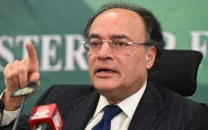PIA to achieve break-even in 2025
Consultant recommends addition of 20 aircraft, administrative overhaul for turnaround

A foreign consultant on Tuesday presented a fiveyear business plan to the government for the revival of Pakistan International Airlines (PIA) and recommended the addition of 20 aircraft to the fleet and administrative and financial overhaul to turn around the airline by 2026.
IATA Consulting gave a synopsis of the business plan to Finance Minister Shaukat Tarin. It revealed that PIA would remain in loss even at the end of the tenure of Pakistan Tehreek-e-Insaf (PTI) government in spite of injecting hundreds of billions of rupees. The consultant suggested that the fleet of PIA – the loss-making national flag carrier that is eating billions of rupees of taxpayers every year without showing any improvement – should go up from 29 to 49 aircraft.
The consultant has proposed the addition of four wide-body aircraft and 16 narrow-body planes. The government was told that by introducing all restructuring measures, it was expected that breakeven could be achieved in the fourth year, indicating that the airline would remain in loss. However, sources said that the PIA management, while agreeing to many proposals, said that the plan was “aggressive and difficult to accept”.
At the time of appointment of Arshad Malik as the chief executive officer of PIA three years ago, Prime Minister Imran Khan had said that Malik would turn around the loss-making entity. But the consultant’s plan showed that PIA was expected to suffer a loss of $120 million in 2022 solely on account of operating cost, which would increase to $156 million in 2023. In 2023 – the last year of PTI’s five-year rule – total revenues are projected at $934 million against operating cost of $1.1 billion.
The plan envisages 23% growth in operating revenue in 2023 against 11% increase in operating cost. Similarly, in 2024, the operational loss is estimated at $62 million, which will convert into an operational profit of $42 million before turning into a marginal operational loss of $5 million in 2026 – the last year of the business plan.
After taking into account the improvement measures under the five-year plan, the consultant said that operating margins would increase by 0.4% in 2025 and 3.4% in the last year of the five-year plan. “Achievement of the projected results and overall success of this business plan is highly dependent on introduction and implementation of the proposed improvement measures,” IATA Consulting informed the finance minister.
Sources said that Tarin remarked that it may require around Rs500 billion to implement the overall plan, including the financial restructuring. The consultant did not give any figure. The consultant recommended that PIA should be allowed to follow private management rules like other airlines and the requirements of Public Procurement Regulatory Authority (PPRA) should be done away with.
It recommended government’s support for the organisational restructuring process and execution of financial restructuring. It also sought exemptions from investigations and multiple audits The consultant shared PIA’s network plan strategy, which included increasing frequencies on the domestic network, focus on international flights on profitable routes, resumption of services to Europe and New York, and addition of new international routes in Asia.
It recommended maintaining point-to-point strategy on routes to North America, the UK, Gulf and Saudi Arabia and introducing a partial hub operation in Islamabad and maintaining extra sections for Hajj and Umrah. The projected aircraft utilisation is to improve up to 15% over PIA’s 2019 values of 10 hours per day. The consultant expected that the domestic market would recover to 2019 levels in 2022, whereas the international traffic levels of 2019 were expected to be regained by 2024. PIA’s repositioning as per the proposed plan takes into account the internal company and external market situation.
The plan’s focus is on regaining the domestic market share, consolidating and realigning the international network, preparing Islamabad for hub operations by 2025, diversifying revenue sources and reducing operating cost. The consultant said that having a two-hub operation was a very expensive proposition and with secondary flights to international destinations, “it becomes even more complex”. Sources said that PIA’s management had certain differences of opinion due to the reasons that the plan was dependent on extraneous factors like financial restructuring, national aviation policy and PPRA exemption.
The management was of the view that some of the structural changes that it had proposed were very aggressive and difficult to accept. The Ministry of Finance, in a press release, said that a five-year recovery roadmap with network strategy was highlighted to make PIA a viable and profitable organisation focusing on increasing efficiency and profitability by considering the domestic market and Pakistani community abroad keeping in view the internal and external challenges facing the entity.



















COMMENTS
Comments are moderated and generally will be posted if they are on-topic and not abusive.
For more information, please see our Comments FAQ